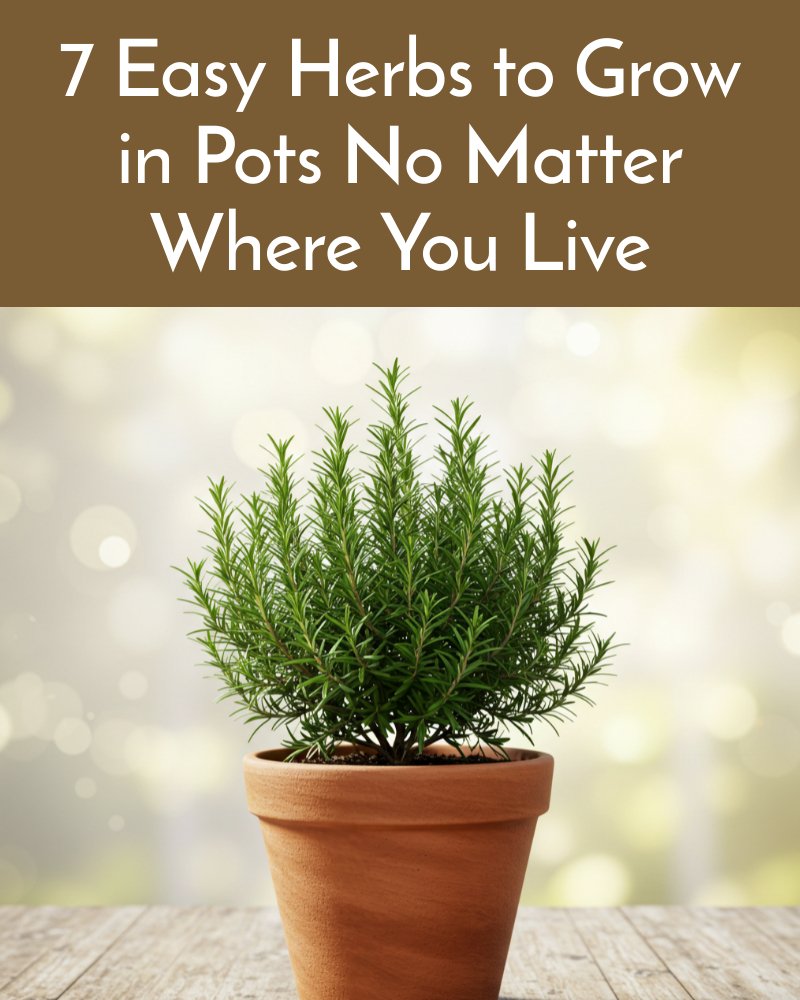Growing your own herbs is one of the simplest and most rewarding ways to add fresh flavors to your meals, elevate your home’s ambiance, and even enjoy some natural health benefits. Whether you live in a sprawling house with a balcony or a tiny apartment with just a windowsill, container gardening makes it possible to cultivate herbs anywhere. The best part? You don’t need a green thumb or a big budget to get started. In this guide, we’ll explore 7 easy herbs to grow in pots no matter where you live, along with tips to ensure they thrive in any space.
Why Grow Herbs in Containers?
Container gardening is a game-changer for herb enthusiasts. It’s versatile, space-efficient, and perfect for beginners. Pots allow you to control soil quality, drainage, and sunlight exposure—key factors in growing healthy herbs. Plus, they’re portable, so you can move them indoors during harsh weather or rearrange them to suit your space. Whether you’re in a bustling city or a rural retreat, these seven herbs will flourish with minimal effort.
Let’s dive into the list!
1. Basil: The King of Container Herbs
Why It’s Easy: Basil is a fast-growing herb that loves warmth and sunlight, making it ideal for pots placed near a sunny window or on a balcony.
How to Grow It:
- Use well-draining soil and a pot at least 6-8 inches deep.
- Water when the top inch of soil feels dry, but avoid overwatering.
- Pinch off the tops regularly to encourage bushy growth.
Best Varieties: Sweet basil, Thai basil, or Genovese basil.
Uses: Perfect for pesto, salads, or garnishing pasta dishes.
Basil thrives in containers because you can easily move it indoors if temperatures drop below 50°F (10°C). With just 6-8 hours of sunlight daily, you’ll have a steady supply of fragrant leaves.
2. Mint: The Low-Maintenance Crowd-Pleaser
Why It’s Easy: Mint is practically indestructible and grows like wildfire, even in small spaces.
How to Grow It:
- Plant in a pot with drainage holes (mint hates soggy roots).
- Use rich, moist soil and place it in partial shade or full sun.
- Trim it back often to prevent it from taking over.
Best Varieties: Peppermint, spearmint, or chocolate mint.
Uses: Add to teas, desserts, or cocktails like mojitos.
Mint is a must-have for container gardening because it adapts to almost any environment. Keep it in its own pot, though—its roots can spread and crowd out other plants.
3. Parsley: The Hardy All-Rounder
Why It’s Easy: Parsley is slow to start but tough as nails once established, tolerating a range of light conditions.
How to Grow It:
- Sow seeds in a pot with rich, well-draining soil.
- Water consistently to keep soil moist but not waterlogged.
- Place in full sun or partial shade (4-6 hours of light).
Best Varieties: Flat-leaf (Italian) or curly parsley.
Uses: Great for garnishes, soups, or homemade tabbouleh.
Parsley’s versatility makes it a top pick for beginners. It’s biennial, meaning it can last two years, giving you plenty of time to enjoy its fresh, earthy flavor.
4. Thyme: The Drought-Tolerant Delight
Why It’s Easy: Thyme thrives on neglect, needing little water and tolerating poor soil conditions.
How to Grow It:
- Use sandy or well-draining soil in a small pot (4-6 inches deep).
- Water sparingly—let the soil dry out between waterings.
- Place in full sun for at least 6 hours a day.
Best Varieties: Common thyme, lemon thyme, or creeping thyme.
Uses: Season roasted meats, veggies, or breads.
Thyme’s compact size and low-maintenance nature make it perfect for small spaces like a kitchen counter or patio. It’s also pest-resistant, so you won’t need to fuss over it.
5. Rosemary: The Fragrant Survivor
Why It’s Easy: Rosemary is a hardy perennial that loves sunny, dry conditions—ideal for pots.
How to Grow It:
- Plant in well-draining soil with a bit of sand or gravel mixed in.
- Water only when the soil is dry (overwatering is its enemy).
- Give it 6-8 hours of sunlight daily.
Best Varieties: Tuscan Blue or Prostratus (trailing type).
Uses: Flavor stews, grilled meats, or infused oils.
Rosemary’s woody stems and needle-like leaves add a decorative touch to your space. It’s slow-growing but can live for years with the right care.
6. Chives: The Space-Saving Superstar
Why It’s Easy: Chives are compact, fast-growing, and require minimal attention.
How to Grow It:
- Use a small pot with well-draining soil.
- Water regularly to keep soil slightly moist.
- Place in full sun or partial shade (4-6 hours of light).
Best Varieties: Common chives or garlic chives.
Uses: Sprinkle on potatoes, eggs, or salads for a mild onion kick.
Chives are perfect for tiny spaces—they grow upright and don’t sprawl. Snip the tops as needed, and they’ll keep producing all season long.
7. Oregano: The Mediterranean Marvel
Why It’s Easy: Oregano is drought-tolerant and loves sunny, warm spots, making it a breeze to grow in pots.
How to Grow It:
- Plant in well-draining soil in a pot at least 6 inches deep.
- Water sparingly—let the soil dry out between waterings.
- Ensure 6+ hours of sunlight daily.
Best Varieties: Greek oregano or Italian oregano.
Uses: Essential for pizzas, sauces, and marinades.
Oregano’s trailing growth habit makes it a beautiful addition to hanging pots or shelves. It’s also a perennial, so it’ll come back year after year with little effort.
Tips for Growing Herbs in Pots Anywhere
To make your container herb garden a success, keep these pointers in mind:
- Choose the Right Pot: Ensure each pot has drainage holes to prevent root rot.
- Soil Matters: Use a high-quality potting mix designed for containers, not garden soil.
- Light is Key: Most herbs need 4-8 hours of sunlight daily—south-facing windows or balconies work best.
- Water Wisely: Overwatering is the top killer of potted herbs. Check soil moisture before adding more.
- Harvest Often: Regular trimming encourages growth and keeps plants healthy.
Even if you’re short on space, you can stack pots vertically or use a tiered plant stand to maximize your setup.
Benefits of Growing Your Own Herbs
Beyond the convenience of fresh herbs at your fingertips, container gardening offers plenty of perks:
- Cost Savings: No more buying overpriced herb bundles that wilt in days.
- Health Boost: Fresh herbs are packed with antioxidants, vitamins, and anti-inflammatory properties.
- Sustainability: Growing your own reduces plastic packaging and food miles.
- Stress Relief: Tending to plants is a proven mood-lifter.
Troubleshooting Common Herb-Growing Problems
- Yellow Leaves: Likely overwatering—cut back and improve drainage.
- Leggy Growth: Not enough sunlight—move the pot to a brighter spot.
- Pests: Aphids or spider mites? Spray with a mild soap-water solution.
With these seven herbs, issues are rare as long as you meet their basic needs.
Conclusion: Start Your Herb Garden Today
No matter where you live—urban apartment, suburban home, or rural retreat—these 7 easy herbs to grow in pots bring flavor, fragrance, and fun to your space. Basil, mint, parsley, thyme, rosemary, chives, and oregano are forgiving, adaptable, and perfect for beginners. All you need is a pot, some soil, and a little sunlight to get started.
So, why wait? Pick one (or all seven!) of these herbs, grab a container, and enjoy the satisfaction of homegrown goodness. Have a favorite herb or tip to share? Let us know in the comments below!


